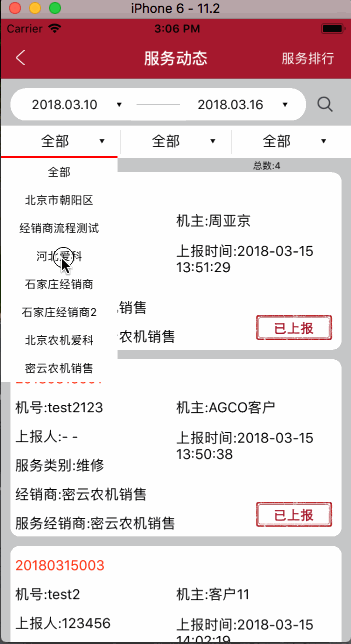iOS - 自定义下拉菜单框
2018-03-16 15:22 菜鸟Alex 阅读(9773) 评论(0) 收藏 举报-
先上效果图
![]()
-
上图设置的是点击cell后隐藏弹出的菜单,或者拖拽tableview隐藏弹出菜单, 或者点击当前页面的cell的时候隐藏.
-
自己可以动态设置弹出框的高度.
-
创建
FMenuAlert继承UIView -
.h文件
//
// FMenuAlert.h
// get_loc_taped
//
// Created by 裴波波 on 2018/1/5.
// Copyright © 2018年 裴波波. All rights reserved.
// 下拉弹框的一个view
#import <UIKit/UIKit.h>
@interface FMenuAlert : UIView
// 显示字体设置
@property(nonatomic,assign)UIFont * cusFont;
/**
点击回调,返回所点的角标以及点击的内容
*/
@property(nonatomic, copy) void(^didSelectedCallback)(NSInteger index, NSString * content);
/// 数据源 数据, 下拉列表的内容数组.
@property(nonatomic, strong) NSArray * arrMDataSource;
// tableview以及cell的背景色, 如果不设置默认白色
@property(nonatomic, strong) UIColor * tabColor;
// 文字的颜色, 默认黑色
@property(nonatomic, strong) UIColor * txtColor;
@end
- .m文件
- 创建一个tableview加到view上
- cell个数即为数据源的数组中数据条数.
//
// FMenuAlert.m
// get_loc_taped
//
// Created by 裴波波 on 2018/1/5.
// Copyright © 2018年 裴波波. All rights reserved.
//
#import "FMenuAlert.h"
@interface FMenuAlert ()<UITableViewDataSource, UITableViewDelegate>
@property(nonatomic, strong) UITableView * tableView;
@end
@implementation FMenuAlert
-(instancetype)initWithFrame:(CGRect)frame{
if (self = [super initWithFrame:frame]) {
[self initUI];
}
return self;
}
-(instancetype)init{
if (self = [super init]) {
[self initUI];
}
return self;
}
-(void)setTabColor:(UIColor *)tabColor{
_tabColor = tabColor;
self.tableView.backgroundColor = tabColor;
}
-(instancetype)initWithCoder:(NSCoder *)aDecoder{
if (self = [super initWithCoder:aDecoder]) {
[self initUI];
}
return self;
}
-(void)initUI{
UITableView * tableView = [UITableView new];
tableView.showsVerticalScrollIndicator = NO;
tableView.frame = self.bounds;
[self addSubview:tableView];
tableView.delegate = self;
tableView.dataSource = self;
self.tableView = tableView;
tableView.rowHeight = 30;
[tableView registerClass:[UITableViewCell class] forCellReuseIdentifier:@"fmenualert"];
}
-(void)setArrMDataSource:(NSMutableArray *)arrMDataSource{
_arrMDataSource = arrMDataSource;
[_tableView reloadData];
}
-(void)tableView:(UITableView *)tableView didSelectRowAtIndexPath:(NSIndexPath *)indexPath{
[tableView deselectRowAtIndexPath:indexPath animated:YES];
if (self.didSelectedCallback) {
self.didSelectedCallback(indexPath.row, _arrMDataSource[indexPath.row]);
}
}
-(NSInteger)tableView:(UITableView *)tableView numberOfRowsInSection:(NSInteger)section{
return _arrMDataSource.count;
}
-(UITableViewCell *)tableView:(UITableView *)tableView cellForRowAtIndexPath:(NSIndexPath *)indexPath{
UITableViewCell * cell = [tableView dequeueReusableCellWithIdentifier:@"fmenualert" forIndexPath:indexPath];
cell.textLabel.text = _arrMDataSource[indexPath.row];
cell.textLabel.textColor = _txtColor ? _txtColor : [UIColor blackColor];
cell.selectionStyle = UITableViewCellSelectionStyleNone;
cell.textLabel.textAlignment = NSTextAlignmentCenter;
cell.contentView.backgroundColor = self.tabColor;
cell.textLabel.backgroundColor = self.tabColor;
cell.textLabel.font = _cusFont ? _cusFont : KFONT(15);
return cell;
}
// 以下适配iOS11+
-(CGFloat)tableView:(UITableView *)tableView heightForFooterInSection:(NSInteger)section{
return 0.1;
}
-(CGFloat)tableView:(UITableView *)tableView heightForHeaderInSection:(NSInteger)section{
return 0.1;
}
-(UIView *)tableView:(UITableView *)tableView viewForFooterInSection:(NSInteger)section{
return nil;
}
-(UIView *)tableView:(UITableView *)tableView viewForHeaderInSection:(NSInteger)section{
return nil;
}
@end
- 如何调用如下:
- 创建并设置必要的属性
- 实现回调
FMenuAlert * alert = [[FMenuAlert alloc] initWithFrame:KFRAME(tag*(KScreen_Width / 3.0), 85, KScreen_Width / 3.0, height)];
self.alert = alert;
alert.cusFont = KFONT(12);
alert.tabColor = KWHITE_COLOR;
[alert setDidSelectedCallback:^(NSInteger index, NSString *content) {
//回调中要实现的功能.
}];



 浙公网安备 33010602011771号
浙公网安备 33010602011771号